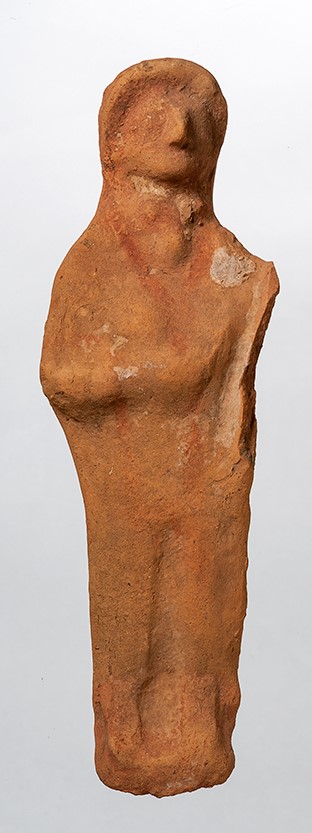Acquisition number: 1973.20
Much of the left arm and the instrument held are missing; the surface is worn. Rather rough orange-buff clay with slight mica and small white and red inclusions. The figurine was made in two halves, the front probably moulded despite the fact that the nose was pinched and the hollow between the legs emphasised with the finger. There is a circular vent in the back; the base is hollow. There is evidence of hair on her right shoulder. Blobs of clay at the neck must indicate jewellery. The front of the figure has an orange-buff clay slip. There are traces of red paint for face, hair and feet and to mark the drapery.
Title: Statuette of a Woman - 1973.20
Acquisition number: 1973.20
Author or editor: J.R. Green
Culture or period: Cypriot.
Date: c. 5th century BC.
Material: Clay - Terracotta
Object type: Sculpture and figurines
Dimensions: 247mm (h)
Origin region or location: Cyprus
Origin city: Achna
Display case or on loan: 3
Keywords: Cypriot, Figurine, Achna, Charles Newton
J.R. Green with B. Rawson, Catalogue of Antiquities in the Australian National University, A.N.U. (Canberra, 1981) 83; J.M. Webb, Cypriote Antiquities in Australian Collections, i (Corpus of Cypriote Antiquities 18, SIMA XX: 18, Jonsered 1997) 51-52 nos 213-216, pl. 16.
1973.20
Statuette of a Woman
Ht 24.7cm.
Cyril Henry Leach Bequest by courtesy of the Trustees of the British Museum; from Achna, Cyprus.
Much of the left arm and the instrument held are missing; the surface is worn. Rather rough orange-buff clay with slight mica and small white and red inclusions. The figurine was made in two halves, the front probably moulded despite the fact that the nose was pinched and the hollow between the legs emphasised with the finger. There is a circular vent in the back; the base is hollow. There is evidence of hair on her right shoulder. Blobs of clay at the neck must indicate jewellery. The front of the figure has an orange-buff clay slip. There are traces of red paint for face, hair and feet and to mark the drapery.
Probably conservative work of the fifth century BC. Note that the figure was not designed to stand. Compare 1973.22 in this catalogue.
Achna lies in south-east Cyprus, about halfway between Larnaka and Famagusta. The sanctuary there was excavated in 1882 by Ohnefalsch-Richter on behalf of Charles Newton, and a proportion of the finds went to the British Museum: M. Ohnefalsch-Richter, Kypros, the Bible and Homer (London 1893) 1-2 and Index. See also A. Caubet, “Achna, 1882: réflexion sur les découvertes du sanctuaire chypro-archaïque et classique”, in: G.C. Ioannides (ed.), Studies in Honour of Vassos Karageorghis (Kypriakai Spoudai 44-45, Nicosia 1992) 261-267.
These figurines represent fairly popular types of the sixth-fifth centuries BC. The females and doubtless the male (?) represent worshippers and would be suitable both for the grave and as votives at a sanctuary. The females of the type seen here are generally described as playing musical instruments, although the detail is rarely clear. Compare Ohnefalsch-Richter, op.cit., pl. 11, 3 and pl. 12, 1 and 3; A. Brown and H. Catling, “Additions to the Cypriot Collection in the Ashmolean Museum, Oxford”, Opuscula Atheniensia 13, 1980, 128-130 nos 100 and 102-103, also from Achna.
The sacred tree was a common motif in Cyprus on seals and vases from the Bronze Age on. In terracotta they are often found at the centre of a circle of dancers. For such terracottas, see Ohnefalsch-Richter 127-131 and pl. 76, Swedish Cyprus Expedition I, passim, and J.L. Myres, Handbook of the Cesnola Collection of Antiquities from Cyprus (New York 1914) 355. Webb gives further parallels: see J.M. Webb, Cypriote Antiquities in Australian Collections, i (Corpus of Cypriote Antiquities 18, SIMA XX: 18, Jonsered 1997).
For Cypriot terracottas more generally, see the excellent study by A. Caubet et al., L’art des modeleurs d’argile. Antiquités de Chypre. Coroplastique (Paris 1998).
J.R. Green with B. Rawson, Catalogue of Antiquities in the Australian National University, A.N.U. (Canberra, 1981) 83; J.M. Webb, Cypriote Antiquities in Australian Collections, i (Corpus of Cypriote Antiquities 18, SIMA XX: 18, Jonsered 1997) 51-52 nos 213-216, pl. 16.
